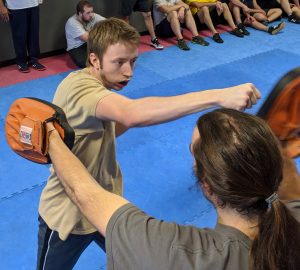THE FIVE CRITERIA FOR GOOD SELF DEFENSE INSTRUCTION
We get it. Looking for self-defense can be daunting when all you know about martial arts is what you’ve seen on TV or heard someone talking about at a party. This section is going to prepare you to find quality instruction no matter where you live. Read on, and you will learn the five criteria for self-defense so you never have to worry about wasting your time or money on training.
Instructor Qualifications
 The first of the five criteria for self-defense is “instructor qualifications.” Sadly, there are no government regulations on the self-defense industry so literally, anyone can claim to be an expert. As a result, there are a lot of charlatans in the industry. Do your homework. Self-defense is a serious business. You wouldn’t go for surgery without researching your doctor. In self-defense, your life is also on the line. Ideally, you want someone who’s actually dealt with non-consensual violence.
The first of the five criteria for self-defense is “instructor qualifications.” Sadly, there are no government regulations on the self-defense industry so literally, anyone can claim to be an expert. As a result, there are a lot of charlatans in the industry. Do your homework. Self-defense is a serious business. You wouldn’t go for surgery without researching your doctor. In self-defense, your life is also on the line. Ideally, you want someone who’s actually dealt with non-consensual violence.
Nick Hughes, for example, began working on nightclub doors when he was only 16 years old. He and the other bouncers averaged five fights a night, six nights a week for six years. You do the math. He’s lived and worked in over 20 countries as a member of the French Foreign Legion and as a bodyguard. Black Belt magazine listed him as one of the top ten most dangerous martial artists in the world and he’s the author of the #1 best-selling self-defense book entitled “How To Be Your Own Bodyguard.” He’s boxed professionally, written for various publications, trained the military and law enforcement, and was a featured instructor for Paladin Press.
Highest Probability
The second of the five criteria for self-defense is “what order are they going to start teaching you?” At Warriors Krav Maga, we have a unique method of teaching the highest probability techniques first so you become more effective faster. One major player in the Krav Maga world starts you out learning how to get out of a two-handed choke. In over 2,000 fights around the world, Nick has never seen anyone attacked that way. The fastest way to make someone dangerous is to teach them how to hit. It’s common sense. If you’re being attacked by someone larger, are you going to shut them down faster by sticking your finger in their eye or trying to throw them or put them in an arm lock? That’s why we begin with striking techniques and progress logically.
Are They Teaching You Soft Skills?
The third element of self-defense is called “soft skills.” Learning how to fight and learning self-defense is vastly different. Too many naive, testosterone-fueled twenty-year-olds think they’re the same thing. They’re not.
75% of self-defense has nothing to do with fighting. In fact, you could argue that if you have to go physical, you screwed up. Crime starts with the selection of a victim. Can you learn how they choose their victims and, therefore, how not to be selected in the first place? Yes, you can, and that’s what we call a soft skill.
How about situational awareness and pre-fight attack cues? Spies and special forces learn this before they venture into the world’s hostile places. Most fights begin with a verbal component. If you can say something to make a situation worse, then you can say something to make it better. These are the techniques of hostage negotiators, and you need to learn them if you want to be good at self-defense. Schools that teach you how to fight only aren’t dealing with any of the above.
Are They Teaching The Legal Ramifications Of Using What They Teach You?

The fourth element of the five criteria for self-defense is “legal ramifications.” We have a saying at Warriors Krav Maga: You have to win two fights. You have to win the physical one, should it become necessary, and you have to win the subsequent legal one. There are organizations that haven’t figured out there’s a difference between what you can do fighting a terrorist on a bus in the Middle East as a soldier versus what you can do here in the US as a civilian.
In martial arts circles, there’s a very famous case where an instructor taught a young man a bunch of different ways to kill someone with a knife. His instructor, however, failed to teach him the legal ramifications of doing so. He stabbed a bouncer in New York, killed him, and is now doing life in prison. The other problem is, that even if you win the legal fight, it’s going to be expensive. $10,000 to $15,000 is the going rate for a halfway decent attorney to represent you in an assault case. However, even if you win the criminal trial, you might still face civil litigation.
Mindset

The final element of the five criteria for self-defense is “mindset.” Many consider it the most important element of all. Ask your potential instructor what else they teach other than techniques, and be prepared for a blank look. They should also be teaching you tactics and mindset. The latter is the most important and also the hardest to teach. We have to be able to take someone who’s passive by nature and mentally prepare them to fight a hardened criminal, someone who’s grown up around violence their entire life, and prevail. Ask your instructor how he’s going to do that. If he’s legitimate, he can answer the question.